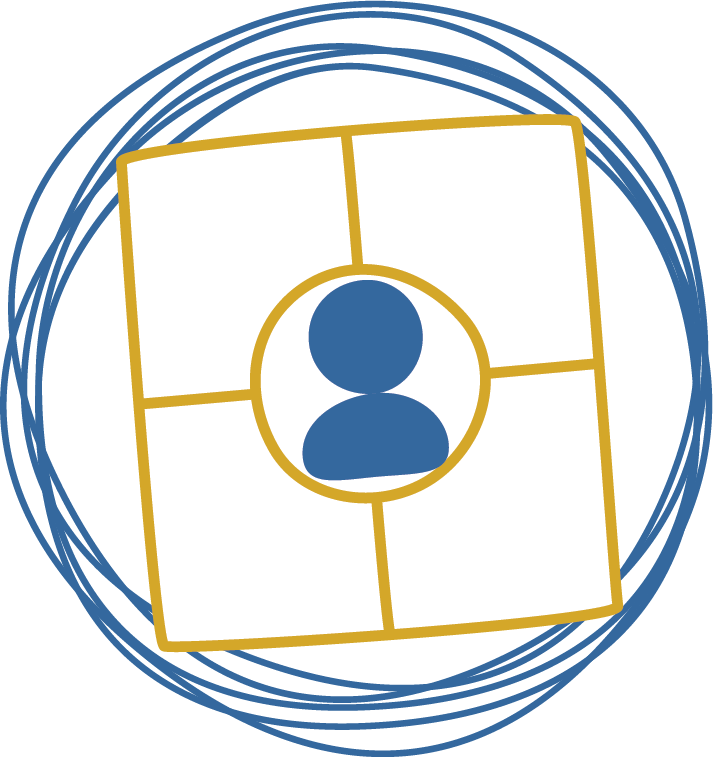An empathy map helps teams build a deeper shared understanding of stakeholders or end users and their role in our business ecosystem. The map can be used to articulate what we know about a particular type of stakeholder and where gaps in our knowledge might lie. Once this knowledge has been externalized and aligned among team members, it can be used to aid future decision making and help guide future user research efforts.
Design Phase: Interpret
Facilitator: 1
Activity Group: 1-10
Time: 1-3 hours, depending on the number of stakeholders
Materials: Sticky notes and markers, Whiteboard or Virtual Whiteboard

Before the Activity
An empathy map helps teams bIdentify one or more stakeholders that you want to explore in your empathy maps. You will create one map per stakeholder. Examples of stakeholders might include a client, a new employee to be onboarded, a prospective student, a partner, etc. For your selected stakeholder, spend a bit of time thinking about the situation they are in and the goals they might have relevant to that situation.uild a deeper shared understanding of stakeholders or end users and their role in our business ecosystem. The map can be used to articulate what we know about a particular type of stakeholder and where gaps in our knowledge might lie. Once this knowledge has been externalized and aligned among team members, it can be used to aid future decision making and help guide future user research efforts.
If you have any user research available for this stakeholder, gather those materials and share them with your participants.
Using a whiteboard, a flipchart or a virtual whiteboard space, create a large diagram with an area titled "Stakeholder” at the center and several sections surrounding. The surrounding areas should be titled “Goals”, “Hearing”, “Seeing”, “Saying”, “Doing”, “Thinking and Feeling”. See the illustration below for a template.
During the Activity
- Introduce the participants to the stakeholder, the situation and the stakeholder goals you are asking participants to consider.
- As you answer the questions in this activity, try to rely as much as possible on things you know from the user research you have conducted. If you do not have research available for any of the questions, make your best guess but mark those items as possible areas where you might want to explore further and conduct additional research to confirm your hunches.
- Starting with the “Goals” section ask your participants to provide more detail around the stakeholder’s situation and goals. Some questions to consider might include “What is their role in the situation?” “What do they want to do differently?” “What decisions do they need to make?” Recording your answers can be done using sticky notes or bullet points in your diagram.
- Next, consider the “Seeing” section. Detail out this area by answering questions such as “What are they seeing in the marketplace? Online? In the media? In their environment?” “What do they see others saying and doing?” “What are they watching and reading?”
- Now focus on the “Hearing” section. Questions to answer here include “What are they hearing from friends and family? From colleagues? From trusted advisors?”
- Repeat the process with the “Doing” section. These questions include “What are they doing today?” “What behaviors have we observed?” “What might we imagine them doing in the future?” Remember that what the stakeholder is doing may be contradictory to what they are saying or thinking.
- Repeat again with the “Saying” section. Questions here include “What have we heard them say? “What might we imagine them saying?” Again, remember that what the stakeholder is saying may be contradictory to what they are doing or thinking.
- In the “Thinking and Feeling” section answer the questions “What are their fears, frustrations, and anxieties?” “What are their wants, needs, hopes, and dreams?” Relevant answers could be about our organization or about the stakeholder’s life, career, or aspirations.
After the Activity
If you have a large participant group, it might be helpful to organize the answers in your empathy map using affinity mapping to synthesize similar ideas.
Your completed empathy map can help you organize and make sense of an existing body of qualitative research (e.g., interview notes, survey answers). You can also use it to identify gaps in your current knowledge base and identify the types of research you need to conduct.
The real power of empathy maps lies in the way they can ensure alignment among team members and allow those team members to empathize with those who intersect with their work. Refer back to your empathy maps as you make decisions about your project, product, or service.
